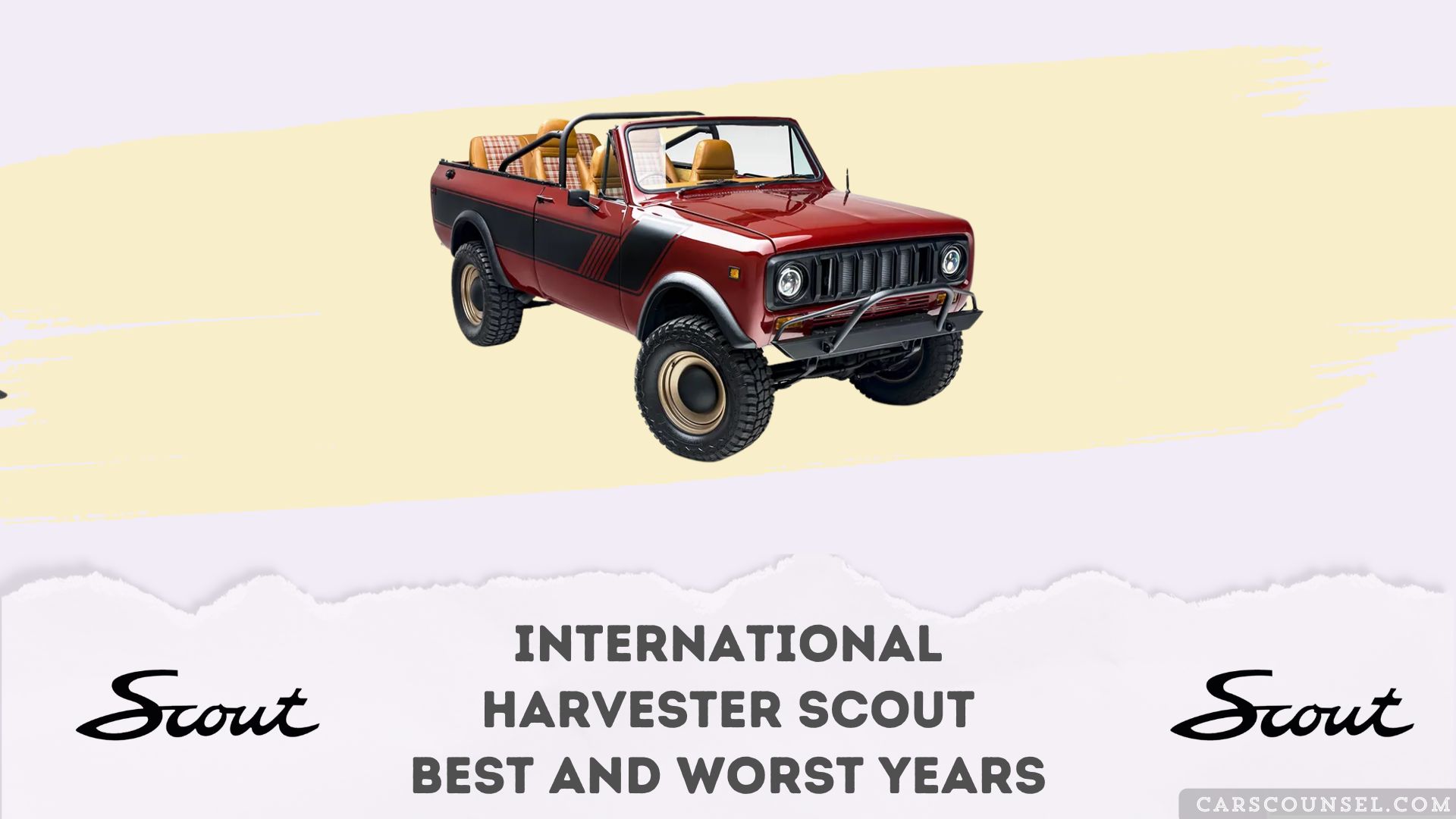As you hold the rusty key to an International Harvester Scout, the thrill of unsealing a piece of history is palpable. The Scout’s rugged exterior hides a complex narrative of triumphs and tribulations, with some years standing out as the best, while others are better left in the dust.
You’re about to set out on a journey to discover the highs and lows of this iconic vehicle, and the secrets that lie beneath its weathered skin.

Quick Navigation
Key Takeaways
- The inaugural Scout generation (1960-1971) is considered the best years for its classic design and rarity in good condition.
- The Scout II (1971-1980) is also popular, offering a range of engine options, including diesel, and catering to various needs and preferences with models like Terra and Traveler.
- The 1976 Scout II models, with the addition of Terra and Traveler, are sought after for their longer wheelbase and increased cargo capacity.
- The worst years for the Scout might be the later models (late 1970s), which may have reliability issues and require more maintenance.
- The restoration process for any Scout model can be challenging, requiring specialized knowledge and careful selection of parts, but offers a unique and customized experience.
Restoring an Icon
You’re taking on a valuable investment by restoring an International Harvester Scout, as these iconic vehicles have become difficult to find in good condition.
As an all-terrain utility vehicle, the Scout requires specialized knowledge for restoration.
With a range of models, including the Scout 80 and Scout II, you’ve got a wide range of restoration options.
Be careful selecting parts, like the Dana 27 axle front and rear, and Dana 18 transfer case, which were later replaced with a Dana 44 rear axle and Dana 20 transfer case.
The Original 1961 Scout 80
As you delve into the original 1961 Scout 80, you’ll notice it overcame early production challenges to deliver unique design features like a fold-down windshield and vacuum-powered wipers.
Its off-road capabilities were impressive, thanks to a four-wheel-drive chassis, Dana 27 axles, and a 47-degree approach angle.
With its minimalistic steel box and 100-inch wheelbase, this rugged SUV was built for adventure.
Early Production Challenges
The original 1961 Scout 80, the first production model, faced significant challenges that threatened to derail its success from the start. You’d think that with over 100,000 units sold in just over 5 years, it was a smooth ride, but that’s not entirely true.
The Scout 80 had its fair share of issues, including vacuum-powered windshield wipers and a fold-down windshield, which, although desirable among off-road enthusiasts, posed production challenges.
| Feature | Description |
|---|---|
| Engine | 4-cylinder powerplant with 93 horsepower |
| Body Styles | Removable hardtop, soft-top, and travel top |
| Chassis | Four-wheel-drive with 100-inch wheelbase and 47-degree approach angle |
Unique Design Features
This rugged off-road vehicle boasted several innovative design features, setting it apart from its contemporaries.
The Scout’s compact body design allowed for a 100-inch wheelbase and 154-inch length, making it ideal for traversing tight trails.
The transfer case, specifically the Dana 18, guaranteed smooth power distribution to its Dana 27 axles.
The unique body design also featured a 5-foot-long bed with concealed fuel tanks, providing ample storage space.
With its robust engine options, the Scout was poised to tackle any terrain, making it a pioneer in the off-road world.
Off-Road Capabilities
Frequently, you’ll find the original 1961 Scout 80 at the forefront of off-road adventures, and for good reason.
Its compact size, high ground clearance, and tough axles make it well-equipped for the trail.
The 4-cylinder powerplant produces 93 horsepower, giving you the power you need to navigate tight trails and rugged terrain.
The Dana 27 front axle and rear axle, along with the Dana 18 transfer case, provide a robust drivetrain for off-road use.
With its IH Scout heritage, the Scout 80’s off-road capabilities are undeniable, making it a reliable choice for your next off-road adventure.
1973 Scout II Revolution
Transforming the off-road scene, Scout II burst onto the market in 1971, boasting a 100-inch wheelbase identical to its predecessors, the Scout 80 and 800 models. You’ll notice it’s about 10 inches longer and 1.5 inches wider than its predecessors.
The Scout II is well-equipped for the trail with high ground clearance and tough Dana axles. However, its removable hard steel roof is quite heavy, making removal and storage inconvenient, and there are sealing issues when the top is reinstalled.
| Model Year | Length (in) | Width (in) |
|---|---|---|
| 1971 | 158.5 | 69.5 |
| 1972 | 159.5 | 70.5 |
| 1973 | 160.5 | 71.5 |
| 1974 | 161.5 | 72.5 |
| 1975 | 162.5 | 73.5 |
1976 International Harvester Scout II Traveler
You’re looking for a vehicle that can handle both on-road comfort and off-road capability with ease.
The International Harvester Scout II Traveler, introduced in 1976, fits the bill. With an additional 18 inches of wheelbase, it’s a cargo-carrying machine with 108 cubic feet of storage space.
Its hatchback-style liftgate makes loading and unloading a breeze.
The Scout II Traveler’s popularity stems from its ability to balance on-road comfort with off-road capability, earning it the title of “4 Wheeler Of The Year” from 4 Wheel magazine.
1963 International Harvester Travelall
The International Harvester Travelall, introduced in 1953, emerged as a direct competitor, spanning four generations until its discontinuation in 1975.
You’ll appreciate the Travelall’s classic styling, particularly in its third generation, produced from the mid-1960s to the early 1970s.
Compared to the Scout, the Travelall’s longer wheelbase offers more interior space and cargo capacity.
Initially, you’d a range of engine options, but later models were limited to a single choice.
The Travelall’s ruggedness, reliability, and versatility made it popular among families and outdoor enthusiasts.
Breathing New Life
You’re considering breathing new life into your Scout, and you’re weighing your options.
If you want to maintain the classic look but upgrade the ride, you can investigate restoration options that preserve the original body while swapping in a modern chassis design.
This path lets you balance nostalgia with modern performance and reliability.
Restoration Options
Finding a Scout in good condition has become a formidable task, as the classic car market increasingly falls in love with these unique vehicles.
However, this doesn’t mean you can’t get your hands on a restored Scout. From the plucky Scout 80 to the iconic Scout II, there really isn’t a bad year for this vehicle in terms of restoration options and potential.
Some restoration options to ponder:
- Scout modernization with Velocity exclusive chassis design
- Restoration of original features and specifications
- Upgrading with modern amenities while maintaining authenticity
- Customizing to fit your personal style and preferences
Modern Chassis Design
With Velocity’s exclusive chassis modernization, your vintage ride gets a new lease on life.
This modern chassis design integrates with your International Harvester, transforming it into a reliable one.
You’ll experience handling, increased stability, and augmented overall performance.
The updated chassis components are carefully crafted to guarantee a smooth ride, reducing the likelihood of unwanted vibrations and noises.
Scout Magic
This rugged all-terrain utility vehicle casts a spell of reliability and versatility, making it a favorite among many off-road enthusiasts.
As an owner, you’ll appreciate the Scout’s capabilities, which include:
- Powerful engine options: 152-cubic-inch Comanche four-cylinder, 232-cid inline-six, 266-cid V-8, and International’s own 304-inch V-8.
- Rugged axles: Dana 27 front and rear, with a Dana 18 transfer case, and later models using a Dana 44 rear axle and Dana 20 transfer case.
- Impressive approach angle: 47 degrees, perfect for traversing rough terrain.
- Configurations: Wagon and truck, offering flexibility for various needs.
VS Custom Scout Chassis
You’re about to experience a game-changer in the world of custom Scout builds: the VS Custom Scout Chassis.
This exclusive design provides a unique platform, accommodating a range of engines, transmissions, and suspension upgrades for maximum customization flexibility.
Off-road enthusiasts will love the strong and reliable foundation for heavy-duty applications, while improved ground clearance and approach/departure angles guarantee better performance in challenging terrain.
Velocity’s Scout modernization process has led to impressive custom builds, showcasing the VS Custom Scout Chassis is a must-have for any serious off-road enthusiast looking to take their Scout to new heights.
Scout Years: 1961 – 1971 Scout 80/800
The inaugural Scout generation, produced from 1960 to early 1971, set the stage for a legendary off-road lineage.
You’ll find the Scout 80/800 was a minimalistic steel box mounted on a four-wheel-drive chassis.
- The Scout 80/800 had a 154-inch length and a 47-degree approach angle.
- You could get it with a wagon body or a pickup, each featuring a removable steel roof.
- It was powered by International Harvester’s Comanche four-cylinder engine, or later, a 196-cid four-cylinder, 232-cid inline-six, or a 266-cid V-8.
- The Scout featured a Dana 27 axle front and rear, with a Dana 18 transfer case, and later, a Dana 44 rear axle and Dana 20 transfer case.
Scout II Production Highlights by Year
You’ll start with the 1971 model, which was introduced in April and came with wagon and truck configurations, as well as Dana 44 axles offered front and rear.
This model year featured a range of engine options, including 196-cid four-cylinder, 232-cid inline-six, 304-cid V-8, and 345-cid V-8 engines.
Five years later, in 1976, the Terra long-wheelbase truck and Traveler wagon models were added to the lineup, giving the Scout a more competitively sized cargo bed.
1971 Model Introduced
April 1971 marked a significant milestone with the introduction of the Scout II, which rolled out in both wagon and truck forms.
This model year saw the Scout II feature Dana 44 axles and a range of engine options, including:
- 196-cid four-cylinder
- 232-cid inline-six
- 304-cid V-8
- 345-cid V-8 engines
You’ll notice that the Scout II was designed to cater to various needs and preferences, making it a versatile and attractive option for those in the market for a reliable vehicle.
1976 Terra Model Added
As 1976 rolled around, International Harvester responded to customer demand for more cargo capacity by adding the Terra model to its Scout II production lineup, marking a significant change in the cargo capacity of the Scout. You now had a choice between the Terra long-wheelbase truck and Traveler wagon models, offering a more competitively sized cargo bed.
| Model | Cargo Capacity |
|---|---|
| Terra | Longer wheelbase for more cargo space |
| Traveler | Longer wheelbase for more cargo space |
| Scout II | Standard cargo bed |
| Jeep Cherokee | Competitor cargo capacity |
Scout 80 Vs Scout II Engine
In terms of powering their respective models, the Scout 80 and Scout II showcase distinct engine lineups that cater to different eras and customer demands.
You’ll notice the Scout 80 was powered by International Harvester’s own designs, including:
- A 152-cubic-inch Comanche four-cylinder engine
- A larger 196-cid four-cylinder
- A 232-cid inline-six
- A 266-cid V-8 and International’s own 304-inch V-8.
In contrast, the Scout II offered a more diverse range of engines, including a diesel option, reflecting the changing requirements of the market, allowing customers to plunge into different options or plummet into a specific choice.
Modified and Restored Scouts
You’ve likely stumbled upon a beautifully restored Scout 80 or Scout II, and you can’t help but wonder what goes into bringing these classic vehicles back to life.
The Scout II’s wide availability of parts and flexibility of engine choices, transmissions, and chassis upgrades make it an attractive option for modifications.
Velocity’s Scout modernization process takes it to the next level with a Velocity-exclusive chassis design, offering a unique and customized restoration experience.
With a thriving community of enthusiasts and experts, you’ll find resources and support to bring your Scout back to its former glory.

